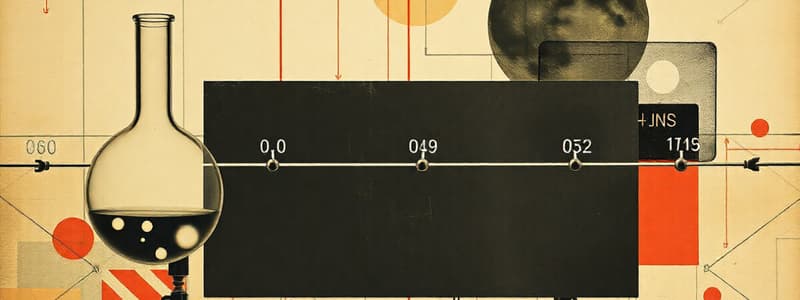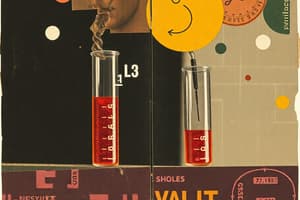Podcast
Questions and Answers
Explain how the reaction quotient, Q, helps predict the direction a reversible reaction will shift to reach equilibrium, and relate this to the equilibrium constant, K.
Explain how the reaction quotient, Q, helps predict the direction a reversible reaction will shift to reach equilibrium, and relate this to the equilibrium constant, K.
Q predicts the shift. If Q < K, the reaction shifts right (towards products). If Q > K, it shifts left (towards reactants). If Q = K, the reaction is at equilibrium.
For the reaction $N_2(g) + 3H_2(g)
ightleftharpoons 2NH_3(g)$, how would increasing the total pressure of the system at equilibrium affect the partial pressure of $NH_3$? Explain using Le Chatelier's principle.
For the reaction $N_2(g) + 3H_2(g) ightleftharpoons 2NH_3(g)$, how would increasing the total pressure of the system at equilibrium affect the partial pressure of $NH_3$? Explain using Le Chatelier's principle.
Increasing the total pressure will shift the equilibrium towards the side with fewer moles of gas, which is the product side ($NH_3$). Therefore, the partial pressure of $NH_3$ will increase.
Briefly describe how a catalyst affects the equilibrium of a reversible reaction. Does it change the equilibrium constant or the rates of the forward and reverse reactions?
Briefly describe how a catalyst affects the equilibrium of a reversible reaction. Does it change the equilibrium constant or the rates of the forward and reverse reactions?
A catalyst does not change the equilibrium constant. It increases the rates of both the forward and reverse reactions equally, allowing equilibrium to be reached faster.
Consider the endothermic reaction: $A(g)
ightleftharpoons B(g)$. If the temperature of the system at equilibrium is decreased, what will happen to the concentration of A? Explain your answer.
Consider the endothermic reaction: $A(g) ightleftharpoons B(g)$. If the temperature of the system at equilibrium is decreased, what will happen to the concentration of A? Explain your answer.
For the equilibrium reaction $2SO_2(g) + O_2(g)
ightleftharpoons 2SO_3(g)$, the enthalpy change, $\Delta H$, is negative. How will increasing the temperature affect the value of the equilibrium constant, K?
For the equilibrium reaction $2SO_2(g) + O_2(g) ightleftharpoons 2SO_3(g)$, the enthalpy change, $\Delta H$, is negative. How will increasing the temperature affect the value of the equilibrium constant, K?
Explain how the relative intensities of peaks in a mass spectrum can be used to determine the isotopic abundance of an element.
Explain how the relative intensities of peaks in a mass spectrum can be used to determine the isotopic abundance of an element.
Describe the key differences between bonding and antibonding molecular orbitals in terms of electron density and energy levels.
Describe the key differences between bonding and antibonding molecular orbitals in terms of electron density and energy levels.
How does increasing the number of nodes in a molecular orbital affect its energy, and why?
How does increasing the number of nodes in a molecular orbital affect its energy, and why?
Explain why homonuclear diatomic molecules of the second period (Li to Ne) do not all exist as stable diatomic species. Use molecular orbital theory.
Explain why homonuclear diatomic molecules of the second period (Li to Ne) do not all exist as stable diatomic species. Use molecular orbital theory.
Describe the relationship between bond order, bond length, and bond energy. How are they related?
Describe the relationship between bond order, bond length, and bond energy. How are they related?
Explain the concept of resonance and why it is used to represent certain molecules. Provide an example of a molecule that requires resonance structures.
Explain the concept of resonance and why it is used to represent certain molecules. Provide an example of a molecule that requires resonance structures.
How does electronegativity difference between two atoms influence the polarity of a bond? Give an example.
How does electronegativity difference between two atoms influence the polarity of a bond? Give an example.
What are the differences between sigma ($\sigma$) and pi ($\pi$) bonds in terms of their formation and electron density distribution?
What are the differences between sigma ($\sigma$) and pi ($\pi$) bonds in terms of their formation and electron density distribution?
Flashcards
Exam Point Total
Exam Point Total
A chemistry exam worth a total of 100 points.
Exam Identification
Exam Identification
The first exam of Chemistry 112A.
Student ID
Student ID
To be written on each page of the exam.
Exam Duration
Exam Duration
Signup and view all the flashcards
Number of questions
Number of questions
Signup and view all the flashcards
The exam contains
The exam contains
Signup and view all the flashcards
Student ID
Student ID
Signup and view all the flashcards
6-digit WUSTL ID
6-digit WUSTL ID
Signup and view all the flashcards
Chemical Equilibrium
Chemical Equilibrium
Signup and view all the flashcards
Equilibrium Constant (K)
Equilibrium Constant (K)
Signup and view all the flashcards
Method of Successive Approximations (MOSA)
Method of Successive Approximations (MOSA)
Signup and view all the flashcards
Partial Pressure
Partial Pressure
Signup and view all the flashcards
ICE Table
ICE Table
Signup and view all the flashcards
Study Notes
- Exam consists of questions covering representative topics
- Exam is on chemistry
- Professor Bleeke is teaching
- Exam is worth 100 points
Exam Key Details
- The alotted time for the exam is 1.5 hours
- Exam includes 8 questions on 10 numbered pages
- Students are asked to write their student ID on each page of the exam
- The exam also includes a scratch page
Question 1a
- Considers the balanced chemical reaction of 2 ClO (g) = Cl (g) + ClO2 (g)
- K = 4.26 × 10−4 at 385 K
- 1.240 atm of ClO (g) and 0.330 atm of Cl (g) are sealed in a container at 385 K
- No ClO2 (g) is present initially
- Partial pressures of all three gases, ClO (g), Cl (g) and ClO2 (g) (in atm), after equilibrium is established
- Pclo = 1.236 atm
- Pc1= 0.332 atm
- Pc102= 0.00196 atm
Question 1b
- Considers the balanced chemical reaction: BrO (g) + ClO (g) = ClO2 (g) + Br (g)
- The equilibrium constant, K, for this reaction at 385 K is 0.040
- The reaction is endothermic
- Plot A depicts the reaction spontaneously proceeding in the forward direction to reach equilibrium at a temperature greater than 385 K
- Plot B depicts the reaction spontaneously proceeding in the forward direction to reach equilibrium at a temperature greater than 385 K
- Plot C depicts the reaction spontaneously proceeding in the reverse direction to reach equilibrium at a temperature equal to 385 K
Question 2
- Considers generic, balanced chemical reactions that are either endothermic or exothermic in the forward direction
- Each reaction is allowed to reach equilibrium
- Reactions are heated from T1, to T2
- Reaction shifts spontaneously in either the forward or the reverse direction to re-establish equilibrium.
- A) A(g) + 2 B(g) = 2 C(g) is endothermic proceeds in the forward direction
- B) A(g) + B(g) = 2 C(g) is exothermic proceeds in the reverse direction
- C) A(g) + 2 B(g) = C(g) + D(g) exothermic is ambiguous
- D) A(g) + B(g) = C(s) + 2 D(g) endothermic proceeds in the forward direction
Question 3
- The gas phase reaction of 4 NO (g) + 6 H2O (g) = 4 NH3 (g) + 5 O2 (g)
- K = 8.32 × 10-19 at temperature T
- 1.25 atm of NH3(g) and 1.25 atm of O2(g) are placed in a sealed container at temperature T
- No NO (g) or H2O (g) are initially present
- PNH3= 0.251 atm
- Po₂= 0.00119 atm
Question 4a
- The solid compound (NH4)2CO3 decomposes according to the reaction (NH4)2CO3 (s) = 2 NH3 (g) + CO2 (g) + H2O (g)
- Total pressure is 3.52 atm after equilibrium is established after the excess (NH4)2CO3 (s) is sealed in an evacuated container at 750 K
- K = 2.40
Question 4b
- The chemical reaction is at temperature T = 775 K
- The equilibrium constant K at 775 K is equal to 5.47
- When 1.40 atm of each gas are initially sealed in a container at 775 K, a calculation shows that the the Q (3.84) is less than K (5.47), which makes the reaction is spontaneous in the forward direction and no solid forms.
- Minimum of 0.27 atm of NH3 must be added
Question 5a
- A 0.40 M aqueous solution of HF is prepared at 25°C
- Ka (HF, 25°C) = 6.6 × 10-4
- pKa (HF, 25°C) = 3.18
- The percent dissociation is 3.98%
Question 5b
- Determine the number of moles of HClO4 that should be added to 600.0 mL of pure water at 25°C
- Solution should have same final pH as the 0.40 M aqueous solution of HF
- 0.00955 moles should be added
Question 5c
- Comparing a 600.0 mL sample of the 0.40 M aqueous solution of HF and the 600.0 mL sample of the HClO4 solution
- The [H3O⁺] is the same for both solutions after equilibrium is established for each solution
- The same number of moles of OH- would be required to completely neutralize each solution.
- Both solutions would have a pH of 7.00 after completely neutralizing the acids with OH
Question 6a
- Ka for the weak acid, hypochlorous acid, HClO, is 3.0 ×_10-8 (pKa=7.53) at 25°C
- The mass of solid potassium hypochlorite, K+ClO¯, that must be added to a 500 mL aqueous solution of 0.10 M HClO to prepare a buffer solution with pH = 8.00 is 13.4 grams
Question 6b
- The equilibrium chemical equation is ClO (aq) + H2O (l) = HClO (aq) + OH¯ (aq)
Question 6c
- 50 mL of a 0.20 M aqueous HCl solution is added to the buffer (from part a)
- The pH = 7.89
Question 6d
- The number of moles of KClO that must be added to the buffer solution in part (c) to bring it back to the original pH of 8.00 is 0.0391 mol
Question 7a
- 200.0 mL aqueous solution at 25°C contains a weak, monoprotic acid, HA
- Titrated with a 0.50 M aqueous solution of NaOH at 25°C
- 0.076 moles HA
Question 7b
- 0.076 moles of HA is converted to A- after adding of 152 mL NaOH
- Kb = 5.32 × 10-10
Question 7c
- The monoprotic weak acid, HA from the titration is HN3
- Ka = 1.9 × 10-5
Question 8a
- 500.0 mL of a 0.50 M aqueous solution of MgCl2 is added to 250.0 mL of a 0.50 M aqueous solution of NaF at 25° C
- A precipitate of the sparingly-soluble salt, MgF2, is formed
- MgCl2 and NaF are completely soluble in water to produce Mg2+, Cl-, Na+, and F− ions
- Ksp for MgF2 = 6.6 × 10-9 at 25°C
- MW (MgF2) = 62.30 g/mol
- 3.89 grams of MgF2 precipitates
Question 8b
- The mass of MgF2 that re-dissolves is 3.79 × 10-3 grams MgF2
Studying That Suits You
Use AI to generate personalized quizzes and flashcards to suit your learning preferences.




